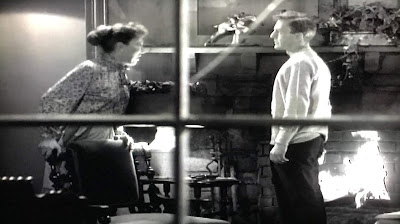 |
|
The "Abdominal Snowman" tries The
Flight of the Bumblebee on a Thompson submachine gun.
|
Among
the droll avant-propos Alfred
Hitchcock delivered as host of his half-hour weekly television mystery program,
one is remarkable for giving insight into the work of this film auteur.
In
his facetiously macabre and blasé introductions to the teleplays of Alfred Hitchcock Presents, the eponymous
host ironically adopted the persona of an old-time London music hall master of
ceremonies. He referred to the drama that followed as an “opera bouffe”,
“somber little jape”, or “little faux pas de deux”, and famously rolled his
eyes with viewers as he poked fun at the show’s sponsors.
 |
|
Use the word “meta” and Alfred Hitchcock might reach for a detonator.
|
However,
in an 1956 episode titled Alibi Me,
directed by Jules Bricken, Hitchcock gives what sounds as though a
concise and poetic description of his artistic process. He did this facing the
camera holding a musical conductor’s baton:
 |
|
A film auteur poetically explains his
style introducing the episode Alibi Me
(Alfred Hitchcock Presents 1956).
|
“Good
evening. One of the commonest questions that people ask our producer of mystery
motion pictures is: Which is written first, the words or the music? In our
case, the background music always comes first. After it is written, we sprinkle
the score liberally with sound effects, and then have an author write
appropriate scenes to accompany the music: quiet scenes to coincide with the
sober passages; and scenes of violence to synchronise with the noisier
sections. Finally, we garnish this potpourri with a title composed of from one
to four words, selected because they are eye-catching and provocative. And we
arrange them in a manner designed to titillate and confuse. Let me show you
what one of our stories sounds like before it is written.”
 |
|
“How fortissimo can you get?” Alfred Hitchcock
conducts a picture in sound.
|
Hitchcock
turns his back on the camera and uses the baton energetically to “conduct” a
series of sound effects: a woman’s scream, gunshots, an alarm, more gunshots,
another scream, squealing tires, a machine gun, et cetera. He then turns to the
camera and says, nearly out of breath: “How fortissimo can you get!” The
vignette takes no more than a brief moment. He concludes by offering his
audience the night’s episode as “music and sound effects and another story to
accompany them.”
The
director famously built his stories around shots. Substitute the words “image”
and “visual effects” for “music” and “sound effects” and you have a quick sketch
of his filmmaking style. This sensibility formed in the silent era is just as
present in Psycho (1959) and The Birds (1963) as it is in his classic
boxing silent film The Ring
(1927). And we see it in the episode One More Mile to Go (1957) which
Hitchcock directed. The result is a classic Hitchcock vignette surprising for
1950s television: the first ten minutes is told in shots without dialog. The
camera approaches a house with a lighted living room and observes a couple’s
argument unseen through a picture window, closing in like a snooping neighbor
as things heat up.
 |
|
David Wayne and Louise Larrabee in the
silent sequence in One More Mile to Go
(Alfred Hitchcock Presents 1956).
|
 |
|
Hitchcock’s camera eye pries closer into
the silent sequence in One More Mile to
Go (Alfred Hitchcock Presents
1956).
|
Alfred Hitchcock Presents aired weekly in
half-hour episodes on CBS from 1955 to 1962. The facetious introductions follow
the show’s iconic nine-stroke profile designed by Hitchcock (his first movie
job was creating title cards for silent films) and its well-known theme music,
Charles Gounod’s Marche funèbre d'une
marionette. Though his absurdist and often visually inventive presentations
can have the feel of a Luis Buñuel or Ernie Kovacs, they are likely closest to the
London music hall humor he knew as a boy and used in his early films.
 |
|
A famous profile and Charles Gounod’s Marche funèbre d'une marionette
announced CBS’s Alfred Hitchcock Presents
(1955-1962).
|
The
dramas featured established actors like Claude Rains and Jessica Tandy,
longtime character actors like Robert Emhardt, and up-and-comers like William
Shatner and Cloris Leachman. Hitchcock directed 17 of the 268 total episodes
with John L. Russell Jr. as his cameraman (Russell shot 75 episodes).
 |
|
The portly Alfred Hitchcock fits
comfortably in the television canon.
|
In
addition to Hitchcock, three dozen directors worked on the program, including
Ida Lupino, Robert Altman, and Paul Henreid, best remembered for his role as
the Czech freedom fighter Victor Laszlo in Casablanca
(1942). The stories adapted for television are by authors ranging from Ambrose
Bierce to Ray Bradbury. They include classics like Roald Dahl’s Lamb to Slaughter (1958) with Barbara
Bel Geddes, and Saki’s (H.H. Munro) The
Schartz-Metterklume Method (1960) with Hermione Gingold.
To
borrow a Hitchcock parting line: “Now, if you’ll excuse me, I must hurry off to
a little social affair. A dear friend is the guest of honor. It’s a stoning. I
wouldn’t miss it for the world.”
Alfred Hitchcock Presents 1955-1962 US. Shamley Productions and Columbia Broadcasting System
(CBS). [This is a revision of the article posted 22 January.]

No comments:
Post a Comment